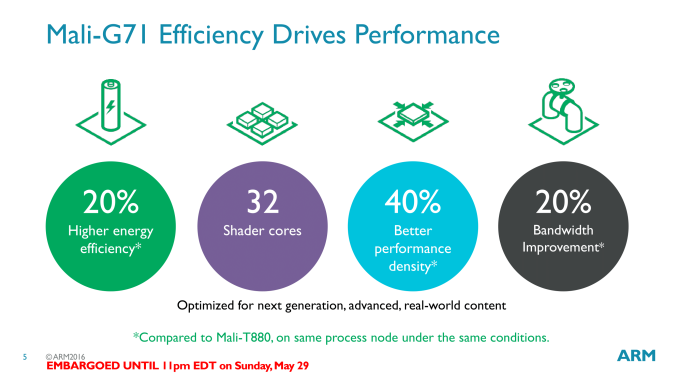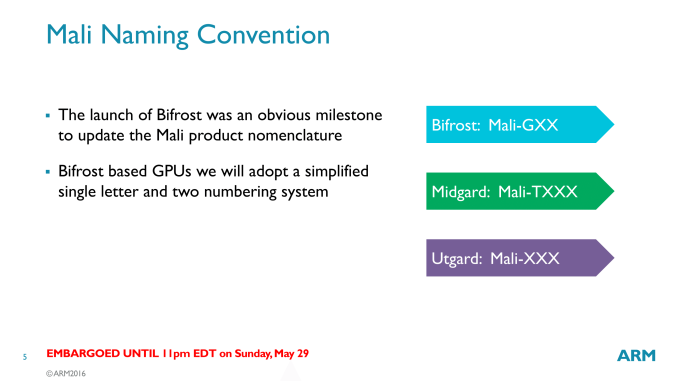ARM Unveils Next Generation Bifrost GPU Architecture & Mali-G71: The New High-End Mali
by Ryan Smith on May 30, 2016 7:00 AM ESTWrapping Things Up: Mali-G71, Coming Soon
Like ARM’s associated Cortex-A73 announcement, today’s Mali-G71 revelations are being made ahead of actual silicon availability. To that end a lot of ARM’s projections are based on early prototyping of manufacturing process and architectural simulations, though at this late stage those simulations tend to be pretty close.
ARM’s official numbers for G71 call for it to offer significant improvements over a same-process Mali-T880 with respect to both energy efficiency and density. For the former ARM is expecting G71 to deliver 20% better energy efficiency over T880, and on the latter to offer 40% better performance density – or in other words, the same performance at 40% less die space. Though ARM has not been heavily penalized for area efficiency, the latter has been one of the few areas where they haven’t done quite as well, and is something competitor Qualcomm is keen to call them out on.
From a performance standpoint, ARM is expecting G71-based devices to offer around 1.5x the performance of current, T880 devices. This is a slightly fuzzier metric – it’s not 50% faster at the same MP configuration – but rather a combination of manufacturing improvements, a larger number of shader cores, and Bifrost architectural improvements. Andrei also suspects that if we were looking at apples-to-apples ISO-power/ISO-area numbers where everything was held equal, the actual performance gains would be even greater.
With all of that said, expect to see G71 operate a lot like a drop-in replacement for current Mali GPUs when it comes to graphics. Bifrost is an architectural update for Mali rather than a feature update. There are no major graphics features that G71 supports that T880 does not; both deliver on the same OpenGL ES and Vulkan graphics functionality. The heterogeneous compute functionality on the other hand stands to make a big impact for general compute tasks, just not for graphics.
Ultimately what this gets ARM is a chance to recalibrate their architecture for the future, to better align with both what software developers are writing and what device manufacturers need in their GPUs. Bifrost is the new modern Mali, and the shift to a TLP-centric design should serve ARM well in the future based on what we’ve seen similar shifts do for AMD and others. Meanwhile the overall performance gains will allow ARM and its customers to hedge their bets on things such as 4K phones and mobile VR, giving them a more suitable GPU design to use if those innovations prove popular.
Wrapping things up, while ARM is only announcing the Mali-G71 today, the company has clearly left the door open to future GPU designs. As a high-end GPU design, G71 is the immediate successor to the T880, but I expect in time that ARM will want to produce GPU designs suitable to replace Mali T820 and the like. That ARM started at G71 is a good hint of what’s to come; future Bifrost GPUs will use the two digit G numbering scheme, so you can easily see where future GPUs may slot in.













57 Comments
View All Comments
Andrei Frumusanu - Monday, May 30, 2016 - link
> it's cheaper this way than buying license to modify these cores (and you have to add R&D costs of modifying uarch).There is no such license. ARM does not allow vendors to modify the licensed micro-architectures, even on the newly announced license it's ARM themselves which do the modifications, not giving vendors access to change the RTL.
http://www.anandtech.com/show/10366/arm-built-on-c...
Tabalan - Monday, May 30, 2016 - link
I meant architecture license, custom design cores. My bad, used wrong phrase, thanks for pointing that out.Shadow7037932 - Monday, May 30, 2016 - link
Samsung sells the Exynos, but vendors are unlikely to jump ship from Qualcomm because the OEMs already know the Qualcomm stuff well.FullmetalTitan - Monday, May 30, 2016 - link
Also a bit of global supply economics in play there. Samsung uses Exynos chips in their flagship phones in the Asian market and sometimes select parts of the European market, but typically they buy from Qualcomm for the NA market and majority of Europe due to marketing, existing penetration, etc. It also helps that Samsung currently is a fabricator of the newest Snapdragon SoCs in both Korea and the U.S. and that affords them prime pricing.They would be slapping the right hand with the left by getting too deep into the R&D and fighting for market share with Exynos. It would be taking revenue from their foundry business to try to grow their design business, and margins in mobile logic are pretty slim these days.
Howard72 - Monday, May 30, 2016 - link
Mali G71 parallel architecture is now consider as RISC SIMD?Howard72 - Monday, May 30, 2016 - link
*considerdOEMG - Monday, May 30, 2016 - link
I hope they also push this to the low-end, at least for the sake of API parity (Vulkan! Vulkan! Vulkan!) among a wide range of devices.LeptonX - Monday, May 30, 2016 - link
"In just six years, the number of GPU vendors with a major presence in high-end Android phones has been whittled down to only two: the vertically integrated Qualcomm, and the IP-licensing ARM."What about PowerVR? Why did you omit them? Aren't they still a major player with GPUs that are at the top both in terms of overall performance and energy-efficiency?
Ariknowsbest - Monday, May 30, 2016 - link
I would consider PowerVR as a major player, after several generations i find them to be very balanced and powerful.But they have lost marketshare to ARM.
So far only bought products with PowerVR and Adreno and a couple Tegras.
Colin1497 - Monday, May 30, 2016 - link
I think the "android" statement is the qualifier. PowerVR is obviously big with Apple as a customer. In the non-Apple space I guess they're more limited? MediaTek uses them?